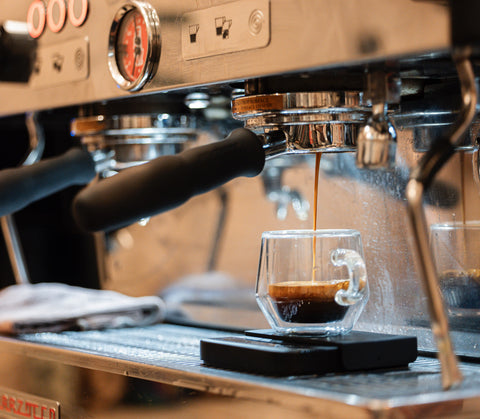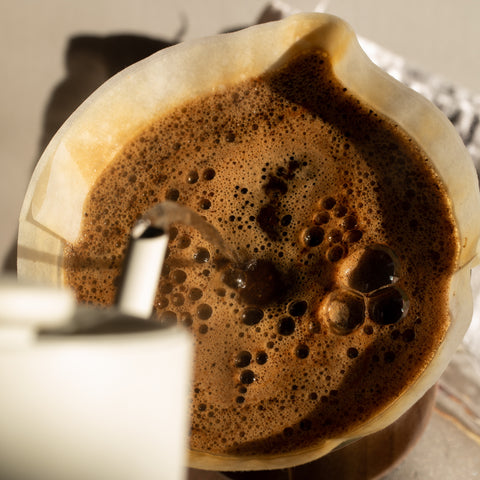With our brew guide, unlock the secrets of crafting the perfect espresso at home, complete with tips and techniques for precision brewing. From preheating your machine to tamping with finesse, this step-by-step tutorial is your key to mastering the art of making an espresso.
1. Preheat the Machine: Turn on your espresso machine and allow it to heat up. Not allowing your machine to heat up will compromise the water temperature, an important variable in the espresso extraction process! In general, home based machines need anywhere from 15-45min to heat up properly.
2. Check the roast date: Ensure the coffee has "rested" - resting is a process that allows the coffee to de-gas and rid itself of compounds created as byproducts during the roasting process that impart characteristics in the cup that are negative. A coffee will taste quite different as espresso 1 day after it's been roasted vs 10. Some roasters recommend rest times of 2 weeks before the coffee has reached its optimal or peak flavor window! Often overlooked, I scoffed at this when first making espresso. It wasn't until I tasted our espresso 1 day off roast and it was almost undrinkable that I realized the importance of resting coffee for espresso!
3. Dose and grind the coffee: A simple set of parameters for brewing espresso is 18g in, 36g out, with a shot time of 25-35 seconds. If you can get close to that, we're in business and we can start modifying from there. Grind your coffee beans just before brewing to ensure freshness. There is no single grind size that's going to work for every coffee. If you're grinding your own beans at home (go you) and trying out different coffees from multiple roasters, every coffee's optimal grind setting is going to be slightly different. The way you determine how to modify your grind setting is by first, tasting the coffee, and second, monitoring the variables in our control. For the sake of brevity here; if your coffee is sour, grind finer. If your coffee is bitter, grind coarser. If you press the button to start your shot and it comes pouring through the portafilter and you get 60g in 20 seconds, make your grind finer. If you press the button to start your shot and it takes 30 seconds before your first drip of black gold, grind more coarsely. We'll do another post just focused on dialing in espresso, this is just a starting point.
4.
Prep the portafilter and tamp the coffee: Place the ground coffee into the portafilter basket. Use a tamper to evenly and firmly press the coffee grounds down. The tamping process should be consistent and level to ensure even water flow through the grounds. Higher quality grinders will create a more even, fluffy bed of coffee. To improve the consistency of coffee in your portafilter, you can buy a
WDT tool to break up any clumps. I feel like I'm raking in a zen garden every time, it's quite satisfying
😂
5. Insert the Portafilter: Attach the portafilter into the machine's group head.
6. Brew: Start the brewing process. The espresso should flow out as a steady stream, with a thick, crema on top.
7. Stop the Extraction: Manually stop the extraction once you've reached the desired volume of espresso in your cup or shot glass.
8. Clean the Machine: It's essential to clean the portafilter, group head, and steam wand to ensure the machine remains in good working condition! Take care of your baby.
As you savor the velvety richness of your homemade espresso, you're experiencing the art of coffee brewing like never before. This brew guide is your roadmap to becoming your own barista, enabling you to create espresso that's truly exceptional. Embrace the journey, perfect your technique, and relish every cup of espresso. It's time to brew like a barista from the comfort of your own kitchen! 😄
Required equipment for espresso:
- Espresso grinder, unless your machine has a built-in grinder. There are MANY options on the market, ranging from $200-$2000. The Baratza Sette 270 ($399) is a bigger commitment than the
Baratza Encore ESP ($199), but will give you far more control over your espresso. If you've read this far, you won't be surprised to see the prices. The at-home espresso rabbit hole runs deep, and can get mighty expensive.
- Tamp mat - for protecting your countertop while tamping down the coffee in your portafilter. Without this, you won't have an even surface, and your counter will hate you.
- Tamper - you absolutely need to tamp the coffee in your portafilter, otherwise you cannot make espresso. This typically comes with a machine, though you may need to buy one separately. Make sure to check the portafilter size and corresponding tamp size!
- Scale - to brew good espresso, you have to be able to control your inputs and measure the outputs. Without measuring, you'll be pulling shots blindly and won't have consistency.
- Timer - use your phone or kitchen timer
- WDT tool - (bonus) - explained in the brew guide above, there are many options out there!



